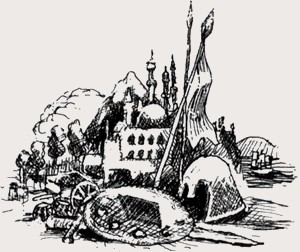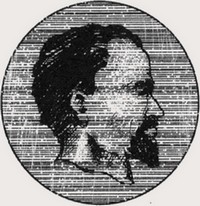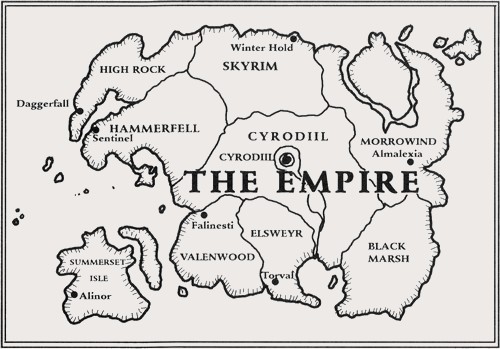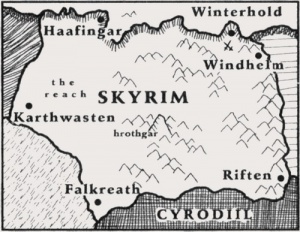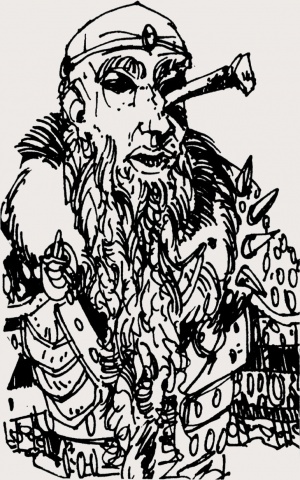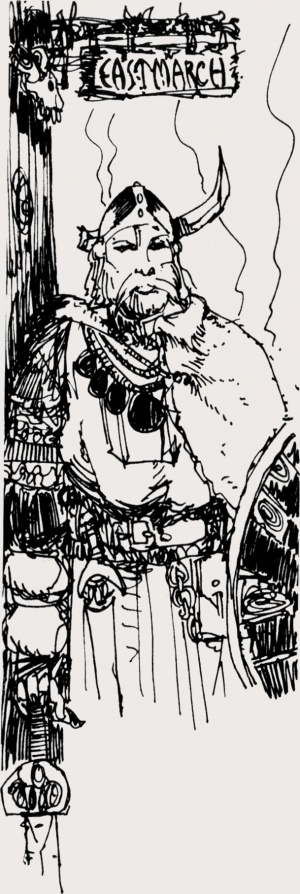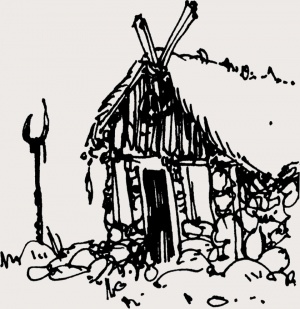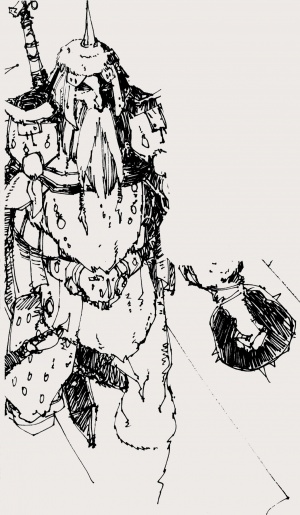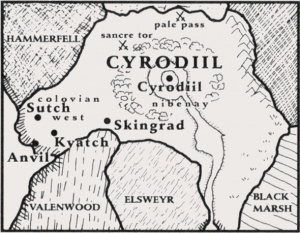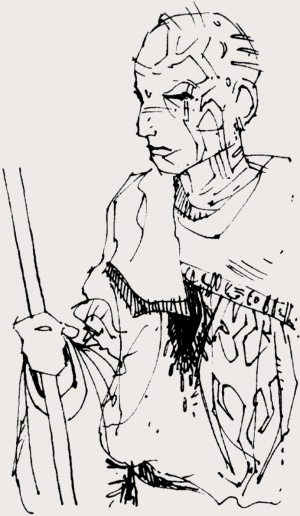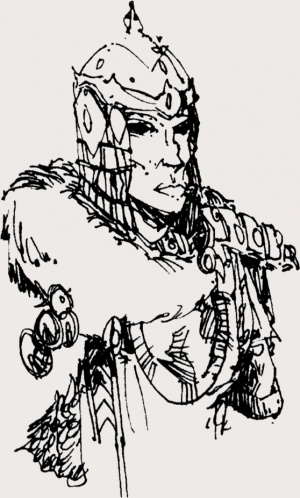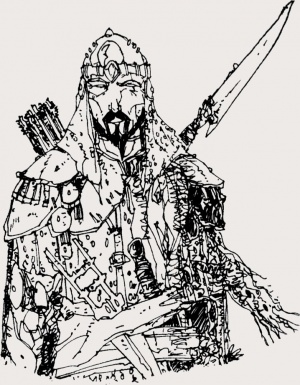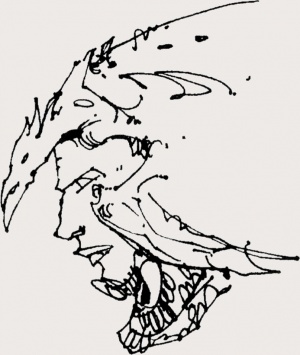Guide de poche de l'Empire, Première édition : Différence entre versions
m |
|||
| Ligne 160 : | Ligne 160 : | ||
|}Cyrodilic history truly begins by the middle of the Alessian Reformation (see sidebar,'' Alessian Order''), when civilization and cultivation had allowed the region to emerge as a discernible Tamrielic power. Its culture and military strength centered in the sacred Nibenay Valley, a grassland expanse with a vast lake at its heart. Several small islands rose from this lake, and the capital city sprawled across them, crisscrossed with bridges and gondola ferries. Rivers connected the city-state to both its profitable outlying territories and the friendly inland ports of Skyrim and Pellitine. Rice and textiles were its main exports, along with more esoteric treasure-goods, such as hide armor, moon-sugar, and ancestor-silk. The sheer size of Cyrodiil's physical theater, and frequent intervals of Elven tyranny, made its unification as a whole a slow and oft-interrupted process. At the height of Alessian influence, its western arm enjoyed a brief autonomy as the Colovian Estates, a demarcation that still colors an outsider's view of the Empire today; often, Cyrodiil has two faces, East and West, and any discussion of its later social history must first be tempered with a summary of this early divergence.<br><br> | |}Cyrodilic history truly begins by the middle of the Alessian Reformation (see sidebar,'' Alessian Order''), when civilization and cultivation had allowed the region to emerge as a discernible Tamrielic power. Its culture and military strength centered in the sacred Nibenay Valley, a grassland expanse with a vast lake at its heart. Several small islands rose from this lake, and the capital city sprawled across them, crisscrossed with bridges and gondola ferries. Rivers connected the city-state to both its profitable outlying territories and the friendly inland ports of Skyrim and Pellitine. Rice and textiles were its main exports, along with more esoteric treasure-goods, such as hide armor, moon-sugar, and ancestor-silk. The sheer size of Cyrodiil's physical theater, and frequent intervals of Elven tyranny, made its unification as a whole a slow and oft-interrupted process. At the height of Alessian influence, its western arm enjoyed a brief autonomy as the Colovian Estates, a demarcation that still colors an outsider's view of the Empire today; often, Cyrodiil has two faces, East and West, and any discussion of its later social history must first be tempered with a summary of this early divergence.<br><br> | ||
| − | [[Image:GuidePocheV1-10.jpg|thumb|<font face="Comic Sans MS" color=#0B0B61>''East<br>(Nibenay)''</font>]]Traditionally, the East is regarded as the region's soul: magnanimous, tolerant, and administrative. It was in the rain forests of the Nibenay Valley that the original Cyro-Nordic tribes, the Nibenese, learned a self-reliance that separated them culturally and economically from Skyrim. The Elven harassment of the First Empire gave rise to an elite form of support troop for the Valley armies, the battlemage. By the time the Alessian Doctrines filtered down from the north along the river trade ways, these mages had become the ruling aristocracy. They were quickly superseded by the Alessian priesthood, whose inexplicably charismatic religion found purchase in the lower classes. The traditional Nordic pantheon of Eight Divines was replaced by a baroque veneration of ancestor spirits and god-animals, practices encouraged by the mutable-yet-monotheistic doctrines of the Alessian faith. The doctrines eventually codified nearly every aspect of Eastern culture. Restrictions against certain kinds of meat-eating, coupled with the sentiments of the blossoming animal cults, soon made agriculture and husbandry nearly impossible. Thus, many of the Eastern Cyrodiils were forced to become merchants, which, over time, allowed the Nibenay Valley to become the wealthiest city-state in the region. Yet, under Alessian rule, no matter how rich or powerful the merchant class became it was still a tenanted citizenry, and the tithes they were forced to pay the priesthood were constant reminders of the state's true masters.<br><br> | + | [[Image:GuidePocheV1-10.jpg|thumb|<font face="Comic Sans MS" color=#0B0B61>''East<br>(Nibenay)''</font>]]Traditionally, the East is regarded as the region's soul: magnanimous, tolerant, and administrative. It was in the rain forests of the Nibenay Valley that the original Cyro-Nordic tribes, the Nibenese, learned a self-reliance that separated them culturally and economically from Skyrim. <u>The Elven harassment of the First Empire gave rise to an elite form of support troop for the Valley armies, the battlemage <font face="Comic Sans MS" color=#0B0B61>''(Our old students forget themselves)''</font></u>. By the time the Alessian Doctrines filtered down from the north along the river trade ways, these mages had become the ruling aristocracy. They were quickly superseded by the Alessian priesthood, whose inexplicably charismatic religion found purchase in the lower classes. The traditional Nordic pantheon of Eight Divines was replaced by a baroque veneration of ancestor spirits and god-animals, practices encouraged by the mutable-yet-monotheistic doctrines of the Alessian faith. The doctrines eventually codified nearly every aspect of Eastern culture. Restrictions against certain kinds of meat-eating, coupled with the sentiments of the blossoming animal cults, soon made agriculture and husbandry nearly impossible. Thus, many of the Eastern Cyrodiils were forced to become merchants, which, over time, allowed the Nibenay Valley to become the wealthiest city-state in the region. Yet, under Alessian rule, no matter how rich or powerful the merchant class became it was still a tenanted citizenry, and the tithes they were forced to pay the priesthood were constant reminders of the state's true masters.<br><br> |
[[Image:GuidePocheV1-11.jpg|thumb|<font face="Comic Sans MS" color=#0B0B61>''Colovian Prince with Bodyguard from Rihad~''</font>]]The West is respected as Cyrodiil's iron hand: firm, unwavering, and ever-vigilant. The Cyro-Nords that settled it had relinquished the fertile Nibenay Valley long ago, determined to conquer the frontier. Their primitive ferocity was disinclined to magic or the need for industry, preferring bloody engagement and plunder instead. After they had captured the Nedic port-cities of the Strident coast, the Westerners embarked on a mastery of the sea. Their earliest voyages took them as far as the Iliac Bay and the Cape of the Blue Divide, whose ports they annually raided until the (then) superior Yokudan navies arrived, ca. 1E810. By the time of the Alessian Reformation, the Westerners were firmly in a position, both geographically and socially, to resist its doctrines. Hammerfell, its northern border state, was now protected by its own holy-avenging order, the Ra Gada, whose bloody intolerance for foreigners acted as West Cyrodiil's buffer against the Alessian priesthood. The pantheon of Eight Divines, therefore, survived unchecked in Western Cyrodiil, and relations with the increasingly Alessian East became strained. Ultimately, the West isolated itself from the theocratic hegemony of the Nibenay Valley, establishing an autonomous government, the Colovian Estates. <br><br> | [[Image:GuidePocheV1-11.jpg|thumb|<font face="Comic Sans MS" color=#0B0B61>''Colovian Prince with Bodyguard from Rihad~''</font>]]The West is respected as Cyrodiil's iron hand: firm, unwavering, and ever-vigilant. The Cyro-Nords that settled it had relinquished the fertile Nibenay Valley long ago, determined to conquer the frontier. Their primitive ferocity was disinclined to magic or the need for industry, preferring bloody engagement and plunder instead. After they had captured the Nedic port-cities of the Strident coast, the Westerners embarked on a mastery of the sea. Their earliest voyages took them as far as the Iliac Bay and the Cape of the Blue Divide, whose ports they annually raided until the (then) superior Yokudan navies arrived, ca. 1E810. By the time of the Alessian Reformation, the Westerners were firmly in a position, both geographically and socially, to resist its doctrines. Hammerfell, its northern border state, was now protected by its own holy-avenging order, the Ra Gada, whose bloody intolerance for foreigners acted as West Cyrodiil's buffer against the Alessian priesthood. The pantheon of Eight Divines, therefore, survived unchecked in Western Cyrodiil, and relations with the increasingly Alessian East became strained. Ultimately, the West isolated itself from the theocratic hegemony of the Nibenay Valley, establishing an autonomous government, the Colovian Estates. <br><br> | ||
| Ligne 166 : | Ligne 166 : | ||
{| class="wikitable" align=right style="border:5px double black; width:250px;" | {| class="wikitable" align=right style="border:5px double black; width:250px;" | ||
| <small>'''The Second Empire'''<br>The Second Empire is divided into two stages: the Reman Dynasty and the Akaviri Potentate. As mentioned in the text, after the Akaviri raiders had been defeated, Reman recruited many of them into his service. Later Cyrodiils traditionally kept a House Guard of Akaviri, and the Emperor's chief advisor, the Potentate, was usually of Akaviri descent. Other Akaviri slaves played a significant part in establishing the administrative structures of the Second Empire, as well as in the training of its military. The restructured Imperial legions, which learned an unparalleled measure of coherence, logistics, and discipline from the Akaviri, began to easily overwhelm the other regional armies; soon every region in Tamriel belonged to Cyrodiil except for Morrowind. After the assassination of Reman's last heir by the Dark Elven Morag Tong during the disastrous Four Score War, control of the Empire reverted to the Akaviri Potentate. They have left a visible mark on the Empire of today. The high crafts of daikatanas and dragonscale armor came from Akavir, as did the banners and military dress of Septim's shock troops, the Blades. The Red Dragons that have come to represent the Empire and the Imperial City were originally Akaviri war mounts. Akaviri surnames are rare and prized possessions among the Cyrodilic citizenry of today, and there are trace facial features of the Akaviri in many distinguished Cyrodilic families. Some colonies of "true Akaviri" still exist in both the Empire and its border regions, but they are named so only for their practices and customs than for the purity of their blood. <small> | | <small>'''The Second Empire'''<br>The Second Empire is divided into two stages: the Reman Dynasty and the Akaviri Potentate. As mentioned in the text, after the Akaviri raiders had been defeated, Reman recruited many of them into his service. Later Cyrodiils traditionally kept a House Guard of Akaviri, and the Emperor's chief advisor, the Potentate, was usually of Akaviri descent. Other Akaviri slaves played a significant part in establishing the administrative structures of the Second Empire, as well as in the training of its military. The restructured Imperial legions, which learned an unparalleled measure of coherence, logistics, and discipline from the Akaviri, began to easily overwhelm the other regional armies; soon every region in Tamriel belonged to Cyrodiil except for Morrowind. After the assassination of Reman's last heir by the Dark Elven Morag Tong during the disastrous Four Score War, control of the Empire reverted to the Akaviri Potentate. They have left a visible mark on the Empire of today. The high crafts of daikatanas and dragonscale armor came from Akavir, as did the banners and military dress of Septim's shock troops, the Blades. The Red Dragons that have come to represent the Empire and the Imperial City were originally Akaviri war mounts. Akaviri surnames are rare and prized possessions among the Cyrodilic citizenry of today, and there are trace facial features of the Akaviri in many distinguished Cyrodilic families. Some colonies of "true Akaviri" still exist in both the Empire and its border regions, but they are named so only for their practices and customs than for the purity of their blood. <small> | ||
| − | |}Things persisted in this vein until the Thrassian Plague of 1E2200 (see ''Free Regions- Thras''), which decimated more than half of Tamriel's population, particularly the western coastlands closest to Thras. After Bendu Olo, the Colovian king of Anvil, led the All Flags Navy to victory over the slugfolk of Thras, the glory of the Cyrodilic people became known throughout the world. The Colovian Estates began to overshadow the richer, more populous East then, which eventually lead to the War of Righteousness that ended Alessian rule. Control of the Nibenay Valley reverted to a mercantile-magocracy that was still far too arcane for Western tastes to entertain a reunification of Cyrodiil. Four hundred years would pass before that would happen, when Reman I, another proud son of the West, rallied the Valley's army to join his own and fight the Akaviri Invasion of 1E2703. The Cyrodilic forces engaged the Akaviri in every region of the north, eliciting their surrender at last in the Pale Pass of Skyrim. By war's end, the Cyrodiils found themselves not only united as a nation, but, too, responsible for the further protection of the northern human kingdoms at large. When the Elves of the Summerset Isles took umbrage at what they perceived as a renewed human imperialism, Reman was forced to prove them right. In order to prevent the Elves from attacking the already weakened northern kingdoms, he offered the captive Akaviri Horde amnesty in his future dominions if they would serve as the nucleus of the Army of the Second Empire of Men. Reman's own dynasty lasted for two hundred years, and in that span it conquered all the kingdoms of Tamriel except for Morrowind. Indeed, the Dark Elven Morag Tong were the doom of Reman's heirs, and the death of the last true Cyrodilic Emperor heralded the beginning of the Common Era. <br><br> | + | |}Things persisted in this vein until the Thrassian Plague of 1E2200 (see ''Free Regions- Thras''), which decimated more than half of Tamriel's population, particularly the western coastlands closest to Thras. After Bendu Olo, the Colovian king of Anvil, led the All Flags Navy to victory over the slugfolk of Thras, the glory of the Cyrodilic people became known throughout the world. The Colovian Estates began to overshadow the richer, more populous East then, which eventually lead to the War of Righteousness that ended Alessian rule. Control of the Nibenay Valley reverted to a mercantile-magocracy that was still far too arcane for Western tastes to entertain a reunification of Cyrodiil. Four hundred years would pass before that would happen, when Reman I, another proud son of the West, rallied the Valley's army to join his own and fight the Akaviri Invasion of 1E2703. The Cyrodilic forces engaged the Akaviri in every region of the north, eliciting their surrender at last in the Pale Pass of Skyrim. By war's end, the Cyrodiils found themselves not only united as a nation, but, too, responsible for the further protection of the northern human kingdoms at large. When the Elves of the Summerset Isles took umbrage at what they perceived as a renewed human imperialism, Reman was forced to prove them right. In order to <u>prevent the Elves from attacking</u><font face="Comic Sans MS" color=#0B0B61>''(Ha!)''</font> the already weakened northern kingdoms, he offered the captive Akaviri Horde amnesty in his future dominions if they would serve as the nucleus of the Army of the Second Empire of Men. Reman's own dynasty lasted for two hundred years, and in that span it conquered all the kingdoms of Tamriel except for Morrowind. Indeed, the Dark Elven Morag Tong were the doom of Reman's heirs, and the death of the last true Cyrodilic Emperor heralded the beginning of the Common Era. <br><br> |
{| class="wikitable" align=right style="border:5px double black; width:250px;" | {| class="wikitable" align=right style="border:5px double black; width:250px;" | ||
| <small>'''The Song of Tiber Septim'''<br>From the Odes: "He was born in Atmora as Talos, 'Stormcrown' in the language of the ancient Ehlnofey, and it was from that shore he sailed. He spent his youth in Skyrim among the Nords. There he learned much from the Tongues and their chieftains and their ways of war. At twenty he led the invasion of Old Hrol'dan, taking it back from the Witchmen of High Rock and their kinsmen.<br>"Soon the Greybeards made known that they were restless. Already the storms had begun from their murmurs. The Greybeards were going to Speak. The surrounding villages were abandoned as the people fled the coming blast.<br>"The villagers warned Talos to turn back, for he was marching to the mountain where the Greybeards dwelt.<br>"Inside he went, and on seeing him they removed their gags. When they spoke his name the World shook.<br>"The Tongues of Skyrim told the son of Atmora that he had come to rule Tamriel and that he must travel south to do so.<br>"And it is true that Talos did come to Cyrodiil shortly after the Battle of Old Hrol'dan.<br>"And it is true that a great storm preceded his arrival."<br><font face="Comic Sans MS" color=#0B0B61>'' ''</font>It is certain that the tale of Talos' conquest of the Cyrodiil through use of his voice is not literally true -- that kind of thu'um is now forbidden. The is all obviously a poetic reference, crafted to satisfy the popular human lust for blood and magic. This young myth is perhaps inspired by Talos' reputation for shrewd diplomacy, attested by even his greatest critics, which permitted him to scheme and bargain his way into the capital city - which he lacked the armies or funds to conquer by dint of force. <small> | | <small>'''The Song of Tiber Septim'''<br>From the Odes: "He was born in Atmora as Talos, 'Stormcrown' in the language of the ancient Ehlnofey, and it was from that shore he sailed. He spent his youth in Skyrim among the Nords. There he learned much from the Tongues and their chieftains and their ways of war. At twenty he led the invasion of Old Hrol'dan, taking it back from the Witchmen of High Rock and their kinsmen.<br>"Soon the Greybeards made known that they were restless. Already the storms had begun from their murmurs. The Greybeards were going to Speak. The surrounding villages were abandoned as the people fled the coming blast.<br>"The villagers warned Talos to turn back, for he was marching to the mountain where the Greybeards dwelt.<br>"Inside he went, and on seeing him they removed their gags. When they spoke his name the World shook.<br>"The Tongues of Skyrim told the son of Atmora that he had come to rule Tamriel and that he must travel south to do so.<br>"And it is true that Talos did come to Cyrodiil shortly after the Battle of Old Hrol'dan.<br>"And it is true that a great storm preceded his arrival."<br><font face="Comic Sans MS" color=#0B0B61>'' ''</font>It is certain that the tale of Talos' conquest of the Cyrodiil through use of his voice is not literally true -- that kind of thu'um is now forbidden. The is all obviously a poetic reference, crafted to satisfy the popular human lust for blood and magic. This young myth is perhaps inspired by Talos' reputation for shrewd diplomacy, attested by even his greatest critics, which permitted him to scheme and bargain his way into the capital city - which he lacked the armies or funds to conquer by dint of force. <small> | ||
| − | |}The Cyrodilic Empire endured for another four hundred years under the auspices of the Akaviri Potentate (see sidebar, ''The Second Empire''), fell, and suffered a similar span of years in the insurrections, misrules, and loss of power known as the Interregnum. Yet, the remnants of the Cyrodilic Empire refused to die, even though both East and West had become fragmented beyond measure. A petty king of the Colovian Estates, Cuhlecain, came to power and appointed an Atmoran as General of his legions. General Talos had studied in Skyrim, and used the ''thu'um''. He could rout armies with his battle-cry and shout lesser men off their feet. A year later more than half of the Cyrodilic Empire was reclaimed or consolidated, and Cuhlecain saw fit to move into the Nibenay Valley, capture the capital city, and proclaim himself Emperor. By this point, High Rock and Skyrim, which bitterly opposed a return to Cyrodilic rule, gathered their armies for a joint invasion of the Colovian West. Talos met them on the field of Sancre Tor. The Nords that had come to cripple the Empire soon joined the General's forces, for when they heard his ''thu'um'' they realized he was Skyrim's Son and the Heir to the Empires of Men. The Bretons were sent back to High Rock with tales of Cuhlecain's new General, where they decided to combat the Emperor's sorcery with their own. In CE854, a nightblade from the Western Reach made his way to the Imperial Palace at Nibenay. There, the Witchman assassinated the Emperor, caught the Palace on fire, and slit the throat of General Talos. ''"But from the smoldering ruin he came, one hand to his neck and with Cuhlecain's Crown in the other. The legions wept at the sight. His Northern magic had saved him, but the voice that led them would be more silent from that night on. His word could no longer rout an army with a roar, but he could still command one with a whisper. He took for himself a Cyrodilic name, Tiber Septim, and the Nordic Name of Kings, Ysmir, the Dragon of the North. And with those names he took, too, the Red Diamond Crown of the Cyrodiils, and became their True Emperor."'' Thus was born the Third Empire of Men. <br><br> | + | |}The Cyrodilic Empire endured for another four hundred years under the auspices of the Akaviri Potentate (see sidebar, ''The Second Empire''), fell, and suffered a similar span of years in the insurrections, misrules, and loss of power known as the Interregnum. Yet, the remnants of the Cyrodilic Empire refused to die, even though both East and West had become fragmented beyond measure. A petty king of the Colovian Estates, Cuhlecain, came to power and appointed an Atmoran as General of his legions. General Talos had studied in Skyrim, and used the ''thu'um''. He could rout armies with his battle-cry and shout lesser men off their feet. A year later more than half of the Cyrodilic Empire was reclaimed or consolidated, and Cuhlecain saw fit to move into the Nibenay Valley, capture the capital city, and proclaim himself Emperor. By this point, High Rock and Skyrim, which bitterly opposed a return to Cyrodilic rule, gathered their armies for a joint invasion of the Colovian West. Talos met them on the field of Sancre Tor. The Nords that had come to cripple the Empire soon joined the General's forces, for when they heard his ''thu'um'' they realized he was Skyrim's Son and the Heir to the Empires of Men. The Bretons were sent back to High Rock with tales of Cuhlecain's new General, where they decided to combat the Emperor's sorcery with their own. In CE854, a nightblade from the Western Reach made his way to the Imperial Palace at Nibenay. There, the Witchman assassinated the Emperor, caught the Palace on fire, and slit the throat of General Talos. ''"But from the smoldering ruin he came, one hand to his neck and with Cuhlecain's Crown in the other. The legions wept at the sight. His Northern magic had saved him, but the voice that led them would be more silent from that night on. His word could no longer rout an army with a roar, but he could still command one with a whisper. He took for himself a Cyrodilic name, <u>Tiber Septim</u> <font face="Comic Sans MS" color=#0B0B61>(Even those humans who revile Talos as a traitor, oathbreaker, and scoundrel pay homage to his skill in obtaining his ends without resort to warfare.)</font>, and the Nordic Name of Kings, Ysmir, the Dragon of the North. And with those names he took, too, the Red Diamond Crown of the Cyrodiils, and became their True Emperor."'' Thus was born the Third Empire of Men. <br><br> |
{| class="wikitable" align=right style="border:5px double black; width:250px;" | {| class="wikitable" align=right style="border:5px double black; width:250px;" | ||
| <small>'''The Cult of the Ancestor-Moth'''<br>For long the Cyro-Nordics had exported ancestor-silks to other regions, simple yet exotic shawls woven from the silks of an indigenous gypsy moth and inscribed with the requisite genealogy of its buyer. Under the Cult, however, ancestor and moth became synonymous: the singing and hymnal spirits of one's forebears are caught in a special silk-gathering ritual, the resource of which is used to create any manner of vestment or costume. The swishing of this material during normal movement reproduces the resplendent ancestral chorus contained therein-it quickly became a sacred custom among the early Nibenese, which has persisted to the present day. Monks of the higher orders of the Cult of the Ancestor-Moth are able to forego the magical ritual needed to enchant this fabric, and, indeed, prefer instead to wear the moths about the neck and face. They are able to attract the ancestor-moths through the application of finely ground bark-dust gathered from the gypsy moth's favorite tree, and through the sub-vocalization of certain mantras. They must chant the mantras constantly to maintain skin contact with the ancestor-moths, a discipline that they endure for the sake of some cosmic balance. When a monk interrupts these mantras, in conversation for example, the moths burst from him in glorious fashion every time he speaks, only to light back upon his skin when he resumes the inaudible chant. <small> | | <small>'''The Cult of the Ancestor-Moth'''<br>For long the Cyro-Nordics had exported ancestor-silks to other regions, simple yet exotic shawls woven from the silks of an indigenous gypsy moth and inscribed with the requisite genealogy of its buyer. Under the Cult, however, ancestor and moth became synonymous: the singing and hymnal spirits of one's forebears are caught in a special silk-gathering ritual, the resource of which is used to create any manner of vestment or costume. The swishing of this material during normal movement reproduces the resplendent ancestral chorus contained therein-it quickly became a sacred custom among the early Nibenese, which has persisted to the present day. Monks of the higher orders of the Cult of the Ancestor-Moth are able to forego the magical ritual needed to enchant this fabric, and, indeed, prefer instead to wear the moths about the neck and face. They are able to attract the ancestor-moths through the application of finely ground bark-dust gathered from the gypsy moth's favorite tree, and through the sub-vocalization of certain mantras. They must chant the mantras constantly to maintain skin contact with the ancestor-moths, a discipline that they endure for the sake of some cosmic balance. When a monk interrupts these mantras, in conversation for example, the moths burst from him in glorious fashion every time he speaks, only to light back upon his skin when he resumes the inaudible chant. <small> | ||
| − | |}Cyrodiil in the Third Empire is the young, vital embodiment of its ancient heritage. Internally, it has undergone an incredible restoration-- reconstruction of the ruined sections of the Imperial City is nearly complete, roads and cities destroyed in the Interregnum have been rebuilt, East and West are unified for the first time in four centuries. Cyrodiil's present stability and strength have not been seen since the Reman Dynasty; indeed, they were born under similar circumstances - a Westerner winning the Eastern throne, forging them both into the greatest power in Tamriel. And now, in but twenty years time, Tiber Septim has secured Imperial authority in High Rock, Skyrim, and Hammerfell. Every human region stands with him against the Elven menace. The Emperor has gracefully attributed his success to his peoples, the Colovians and the Nibenese, whose cultures we shall now treat in their current incarnation.<br><br> | + | |}Cyrodiil in the Third Empire is the young, vital embodiment of its ancient heritage. Internally, it has undergone an incredible restoration-- reconstruction of the ruined sections of the Imperial City is nearly complete, roads and cities destroyed in the Interregnum have been rebuilt, East and West are unified for the first time in four centuries. Cyrodiil's present stability and strength have not been seen since the Reman Dynasty; indeed, they were born under similar circumstances - a Westerner winning the Eastern throne, forging them both into the greatest power in Tamriel. And now, in but twenty years time, Tiber Septim has secured Imperial authority in High Rock, Skyrim, and Hammerfell. <u>Every human region stands with him against the Elven</u> <font face="Comic Sans MS" color=#0B0B61>''(Truly, a doubtful statement)''</font> menace. The Emperor has gracefully attributed his success to his peoples, the Colovians and the Nibenese, whose cultures we shall now treat in their current incarnation.<br><br> |
| − | [[Image:GuidePocheV1-12.jpg|thumb|<font face="Comic Sans MS" color=#0B0B61>''Westerners<br>(Sancre Tor)''</font>]]The Colovians today still possess much of the frontier spirit of their ancestors. They are uncomplicated, self-sufficient, hearty, and extremely loyal to one another. Whenever the East would tremble under the weakness of a leader, the Colovians would withdraw unto themselves, always believing they were keeping the national spirit safe until the storm passed. They realize that the Nibenay Valley is the heart of the Empire and the cultural center of its civilization, but it is a fragile center that only can be held together by the strength of character of its Emperor. When he falters, so do the Colovians. Yet when he is mighty, like Tiber Septim, they are his legions. Today, West Cyrodiils make up the majority of the soldiers in the Ruby Ranks. The Colovian nobility, all officers of the Imperial Legions or its West Navy, do not allow themselves the great expenditure of courtly life as is seen in the capital city. They prefer immaculate uniforms and stark standards hanging from the ceiling of their austere cliff-fortresses; to this day, they become a little perplexed when they must visit the grandly decorated assault of color that is the Emperor's Palace. | + | [[Image:GuidePocheV1-12.jpg|thumb|<font face="Comic Sans MS" color=#0B0B61>''Westerners<br>(Sancre Tor)''</font>]]The Colovians today still possess much of the frontier spirit of their ancestors. They are uncomplicated, self-sufficient, hearty, and extremely loyal to one another. Whenever the East would tremble under the weakness of a leader, the Colovians would withdraw unto themselves, always believing they were keeping the national spirit safe until the storm passed. They realize that the Nibenay Valley is the heart of the Empire and the cultural center of its civilization, but it is a fragile center that only can be held together by the strength of character of its Emperor. When he falters, so do the Colovians. Yet when he is mighty, like Tiber Septim, they are his legions. Today, West Cyrodiils make up the majority of the soldiers in the Ruby Ranks. The Colovian nobility, all officers of the Imperial Legions or its West Navy, do not allow themselves the great expenditure of courtly life as is seen in the capital city. They prefer immaculate uniforms and stark standards hanging from the ceiling of their austere cliff-fortresses; to this day, they <u>become a little perplexed </u> <font face="Comic Sans MS" color=#0B0B61>''(Author oddly sympathetic to the West - a Colovian scribe, perhaps?)''</font> when they must visit the grandly decorated assault of color that is the Emperor's Palace. |
<font face="Comic Sans MS" color=#0B0B61>''An observation: Colovians feel superior to Nibenese as a people, yet, because the East is the Empire's "heart", the Westerners ar often neglected in Cyrodiil -- Even though the throne is taken continually by Kings from the West, the Nibenese quickly assimilate them into their ranks _ ''</font> | <font face="Comic Sans MS" color=#0B0B61>''An observation: Colovians feel superior to Nibenese as a people, yet, because the East is the Empire's "heart", the Westerners ar often neglected in Cyrodiil -- Even though the throne is taken continually by Kings from the West, the Nibenese quickly assimilate them into their ranks _ ''</font> | ||
| Ligne 191 : | Ligne 191 : | ||
[[Image:GuidePocheV1-14.jpg|thumb]]The Emperor's Palace is a crown of sun rays, surrounded by his magical gardens. One garden path is known as Green Emperor Road-here, topiaries of the heads of past Emperors have been shaped by sorcery and can speak. When one must advise Tiber Septim, birds are drawn to the hedgery head, using their songs as its voice and moving its branches for the needed expressions. | [[Image:GuidePocheV1-14.jpg|thumb]]The Emperor's Palace is a crown of sun rays, surrounded by his magical gardens. One garden path is known as Green Emperor Road-here, topiaries of the heads of past Emperors have been shaped by sorcery and can speak. When one must advise Tiber Septim, birds are drawn to the hedgery head, using their songs as its voice and moving its branches for the needed expressions. | ||
| + | |||
| + | <font face="Comic Sans MS" color=#0B0B61>''Or course no mention of the Aldmeri Citadel the capital city was built upon -- or the crimes perpetrated there in the pervious era... ''</font> | ||
---- | ---- | ||
En cours... | En cours... | ||
Version du 19 février 2010 à 02:50
Note : Ce livre est annoté par "YR", un elfe transmettant le présent guide à son oncle accompagné de la lettre suivante. Les annotations écrites comme ceci : Mot commenté (Annotation de YR).
Dans ce texte on peut lire plusieurs fois "CE" ou "Common Era" (ère commune), Il s'agit de la seconde ère.
Severest Uncle,
Before taking my post as military attache in the so-called Imperial City (a foreshadowing of the pretentions of these humans), I took your advice and made a sojourn across the Outerlands, both within this newborn Empire and those regions it has get to acquire ~
Make no mistake, Talos (now Tiber Septim in resplendant Cyrodilic) is still on the ascendant. I now believe the oracles have been badly misinterpreted - Septim may indeed be the Dragonborn as foretold. The Mer must unite at last or be consumed one by one. Father, blessed be his name's numeric mystery, was one of the few on the Thalmor to oppose Andel Crodo's policy of nonintervention that if continued will be the doom of all Elder Races. I understand that my present assignment is intended as a punishment for not following in my father's footsteps, but I urge you to overlook our personal disagreements and to relay my findings to the full Council.
I forward this pamphlet as a sample of the official propaganda from Septim's regime, annotated with my own observations, which while not tempered by age and wisdom are yet valuable as a record of a naive traveller
~YR
to
THE EMPIRE
and its environs
Being a Description of the Lands and the
Divers Customs of the Inhabitants
and furthermore a useful history of those places of interest
by Nature of their Locations & Influence.
Dedicated
To the unswerving Commitment to Truth and Knowledge
of His Most Discerning Majesty the Emperor Tiber Septim
Promulgated under the Authority of the Imperial Geographical Society
CE 864
Scions of Emperors, King of Earth and Sky,
Lord of Shining Hosts,
Protector of Oathman, Freeman and Yeoman,
Guarantor of Right and Justice,
Broad Blessing of Thrones and Powers,
Cynosure of Celestial Glory,
The Most High Tiber Septim
| The 8 Invocations and 16 acceptable Blasphemes.
To AKATOSH whose perch from Eternity allowed the Day. .noitaripsnI fo tnuoF eht HAIHTEOB oT |
Welcome, citizen!
With the dawn of a new era before us, it is time that we take stock of where we have been and where we are, in order to better illuminate the way ahead. Written in celebration of the Battle of Hunding Bay, which marked the return of all human kingdoms to the unchallenged rule (this remains to be seen) of the Cyrodilic Emperor, this pamphlet seeks to briefly describe the present provinces of the Empire and the surrounding regions-- their history, people and current condition. We strove to balance timeliness with accuracy and completeness; if we have erred in our zeal to place this valuable guide in the hands of interested citizens everywhere, we beg the kind reader's indulgence.
The Empire stretches across Tamriel, the largest known continent of the World. To the north of Tamriel is Atmora, from whence the Men of the World came. To the west is Yokuda, the lost native land of the Redguards. To the east is Akavir, whose armies invaded Tamriel in the previous era. To the south all is mystery and the whisper of a lost Elven homeland (So, even the humans have heard of Old Ehlnofey).
Tamriel itself is generally divided into eight major regions: Skyrim, Cyrodiil, High Rock, the Aldmeri Dominion of the Summerset Isles and Valenwood, Hammerfell, Morrowind, and the Elsweyr Confederacy. Some of these, such as Morrowind or Skyrim, have historically been unified into kingdoms; others, such as High Rock or Elsweyr, are looser groupings of many kingdoms, chiefdoms, village confederations, and so forth, united under a dominant race or culture. At its zenith, the Second Empire formally organized these disparate groups into the Imperial Provinces, which were administered by provincial governors, either dispatched directly from Cyrodiil or appointed from the native populations. (Morrowind is a notable exception, having never been conquered by the original Cyrodilic Empire and, thus escaping investment as an Imperial Province.). With the fall of the Cyrodilic Empire, control reverted to the individual rulers of each province, resulting in centuries of chaos, as many of the provinces devolved into independent kingdoms and petty statelets. Now, happily, all of the human kingdoms have been recovered by the Third Empire of Tiber Septim, and once again they all bear the proud title of Imperial Provinces (Breathtaking arrogance!).
The Aldmeri Dominion, the Elsweyr Confederacy, and Morrowind have yet to join the Empire, but are described in this book for the edification of the scholar, the fascination of the common citizen, and the preparation of the soldier. The Third Empire is yet in its youth, and who can predict what new horizons might yet greet the dawn under the Red Diamond Banner?
Some regions escape provincial classification due to the primitive civilization of their beastfolk inhabitants. Collectively, these beastfolk 'states' are known as the Wild Regions, which may or may not be of interest to the Emperor. They are included only for the most intrepid of travelers, and to throw the achievements of Civilization into more brilliant relief by contrast with these benighted corners of Tamriel.
Now, citizen, we entreat you to review our modest survey of the Empire's dominions. If it entertains and edifies, reflect not upon the humble labors of this scribe, but on the gracious benevolence of our beloved Emperor, whose very name is as ambrosia upon our tongues, who in his wisdom has ordained that this survey be created and distributed among the earnest and wise people of Tamriel, that they might better understand the glories and challenges of these Lands and Dominions, and that they might better appreciate the great burdens of rulership he bears in our names with such fortitude.
A note on Elven designations: The Elves as a whole are sometimes referred to as the 'Aldmeri,' or 'the Elder Races.' Their individual pedigrees (Dangerous racialism - there shall be no accomodation as with Reman.) are likewise referred to by both their human and Aldmeri names; thus, High Elves are the 'Altmer,' Dark Elves the 'Dunmer,' Wood Elves the 'Bosmer,' etc., etc. 'Mer' is also used to denote a single Elf. Words that designate an Elven member of a profession or trade can therefore correctly be said as 'craftsmer,' for example, or 'noblemer.
Skyrim, also known as the Old Kingdom or the Fatherland, was the first region of Tamriel settled by humans: the hardy, brave, warlike Nords, whose descendants still occupy this rugged land, and, although perhaps somewhat reduced from the legendary renown of their forebears of old, the Nords of the pure blood still unquestionably surpass the mixed races in all the manly virtues.
Exactly when the Nords first crossed the ice-choked Sea of Ghosts from Atmora, their original homeland, is uncertain. As recorded in the Song of Return, Ysgramor and his family first landed in Tamriel at Hsaarik Head, at the extreme northern tip of Skyrim's Broken Cape, fleeing civil war in Atmora (then rather warmer than at present, as it seems to have supported a substantial population). These first settlers named the land "Mereth", after the Elves that roamed the untamed wilderness which then covered the whole of Tamriel. For a time, relations between Men and Elves were harmonious, and the Nords throve in the new land, summoning more of their kin from the North to build the city of Saarthal, the site of which has recently been located by Imperial archaeologists in the vicinity of modern Winterhold. But the Elves saw that the vital young race would soon surpass their stagnant culture (!) if left unchecked, and fell upon the unsuspecting Nords in the infamous Night of Tears; Saarthal was burned, and only Ysgramor and two of his sons (Ysgramor's provocations and blasphemies have, of course, been long forgotten ~) fought free of the carnage and escaped to Atmora. The Elves, however, had reckoned without the indomitable spirit of the Nords. Gathering his legendary Five Hundred Companions (whose names are still recited every Thirteenth of Sun's Dawn at the Feast of the Dead in Windhelm), Ysgramor returned to Tamriel with a vengeance, driving the Elves out of Skyrim and laying the foundations of the first human Empire.
It may be that the exploits of the near-mythical Ysgramor conflate the reigns of several early Nord Kings, as the Elves were not finally driven from the present boundaries of Skyrim until the reign of King Harald, the thirteenth of Ysgramor's line, at the dawn of recorded history. King Harald is also remembered for being the first King to relinquish all holdings in Atmora; the Nords of Skyrim were now a separate people, whose faces were turned firmly toward their destiny, the conquest of the vast new land of Tamriel. Indeed, the history of the Nords is the history of humans in Tamriel; all the human races, with the exception of the Redguards, are descended from Nordic stock, although in some the ancient blood admittedly runs thin.
| Snow Elves Nords attribute almost any misfortune or disaster to the machinations of the Falmer, or Snow Elves, be it crop failure, missing sheep, or a traveler lost crossing a high pass. These mythical beings are popularly believed to be the descendants of the original Elven population, and are said to reside in the remote mountain fastnesses that cover most of Skyrim. However, there is no tangible evidence that this Elven community survives outside the imaginations of superstitious villagers. Uncle, I saw signs that might be Falmer boundary-runes, but nothing sure. If any survive, they are wary and withdrawn. |
King Vrage the Gifted began the expansion that led to the First Empire of the Nords. Within a span of fifty years, Skyrim ruled all of northern Tamriel, including most of present-day High Rock, a deep stretch of the Nibenay Valley, and the whole of Morrowind. The Conquest of Morrowind was one of the epic clashes of the First Era, when ensued many a desperate contest between Nord and Dark Elf in the hills and glades of that dire kingdom, still recalled by the songs of the minstrels in the alehouses of Skyrim. The system of succession in the First Empire is worthy of note, as it proved in the end to be the Empire's undoing. By the early years of the First Empire, Skyrim was already divided into Holds, then ruled by a patchwork of clan-heads, kings, and councils (or moots), all of which paid fealty to the King of Skyrim. During the exceptionally long reign of King Harald, who died at 108 years of age and outlived all but three of his sons, a Moot was created, made up of representatives from each Hold, to choose the next King from qualified members of the royal family. Over the years, the Moot became permanent and acquired an increasing amount of power; by the reign of King Borgas, the last of the Ysgramor dynasty, the Moot had become partisan and ineffective. Upon the murder (righteous slaying) of King Borgas by the Wild Hunt (see Aldmeri Dominion - Valenwood), the Moot's failure to appoint the obvious and capable Jarl Hanse of Winterhold sparked the disastrous Skyrim War of Succession, during which Skyrim lost control of its territories in High Rock, Morrowind, and Cyrodiil, never to regain them. The war was finally concluded in 1E420 with the Pact of Chieftans; henceforth, the Moot was convened only when a King died without direct heirs, and it has fulfilled this more limited role admirably. It has only been called upon three times in the intervening millenia, and the Skyrim succession has never again been disputed on the field of battle.
The land of Skyrim is the most rugged on the continent, containing four of the five highest peaks in Tamriel (see Places of Note: Throat of the World). Only in the west do the mountains abate to the canyons and mesas of the Reach, by far the most cosmopolitan of the Holds of Skyrim, Nords of the pure blood holding only the barest majority according to the recent Imperial Census. The rest of Skyrim is a vertical world: the high ridges of the northwest-to-southeast slanting mountain ranges, cleft by deep, narrow valleys where most of the population resides. Along the sides of the river valleys, sturdy Nord farmers raise a wide variety of crops; wheat flourishes in the relatively temperate river bottoms, while only the snowberry bushes can survive in the high orchards near the treeline. The original Nord settlements were generally established on rocky crags overlooking a river valley; many of these villages still survive in the more isolated Holds, especially along the Morrowind frontier. In most of Skyrim, however, this defensive posture was deemed unnecessary by the mid-first era, and most cities and towns today lie on the valley floors, in some cases still overlooked by the picturesque ruins of the earlier settlement.
| "The Tongues" The Nords have long practiced a spiritual form of magic known as "The Way of the Voice", based largely on their veneration of the Wind as the personification of Kynareth. Nords consider themselves to be the children of the sky, and the breath and the voice of a Nord is his vital essence. Through the use of the Voice, the vital power of a Nord can be articulated into a thu'um, or shout. Shouts can be used to sharpen blades or to strike enemies at a distance. Masters of the Voice are known as Tongues, and their power is legendary. They can call to specific people over hundreds of miles, and can move by casting a shout, appearing where it lands. The most powerful Tongues cannot speak without causing destruction. They must go gagged, and communicate through a sign language and through scribing runes. In the days of the Conquest of Morrowind and the founding of the First Empire, the great Nord war chiefs - Derek the Tall, Jorg Helmbolg, Hoag Merkiller - were all Tongues. When they attacked a city, they needed no siege engines; the Tongues would form up in a wedge in front of the gatehouse, and draw in breath. When the leader let it out in a thu'um, the doors were blown in, and the axemen rushed into the city. Such were the men that forged the First Empire. But, alas for the Nords, one of the mightiest of all the Tongues, Jurgen Windcaller (or The Calm, as he is better known today), became converted to a pacifist creed that denounced use of the Voice for martial exploits. His philosophy prevailed, largely due to his unshakable mastery of the Voice -- his victory was sealed in a legendary confrontation, where The Calm is said to have "swallowed the Shouts" of seventeen Tongues of the militant school for three days until his opponents all lay exhausted (and then became his disciples). Today, the most ancient and powerful of the Tongues live secluded on the highest peaks in contemplation, and have spoken once only in living memory, to announce the destiny of the young Tiber Septim (as recounted in Cyrodiil). In gratitude, the Emperor has recently endowed a new Imperial College of the Voice in Markarth, dedicated to returning the Way of the Voice to the ancient and honorable art of war. So it may be that the mighty deeds of the Nord heroes of old will soon be equaled or surpassed on the battlefields of the present day. Septim's new college is staffed by hacks and charlatans -- the so-called Grand Master is said to have formerly earned his living as a street performer in Windhelm -- the students are scions of the most obsequious Nord families, hoping to curry favor with Tiber Septim's New Order ~ |
Nords are masters of wood and timber construction; many structures survive in use today that were built by the first settlers over 3,000 years ago. A fine example of Nord military engineering can be seen at Old Fort, one of the royal bastions constructed by the First Empire to guard its southern frontier. Towering walls of huge, irregular porphyry blocks fit together without seam or mortar, as if constructed by mythical Elhnofey rather than men.
The nine Holds present a varied aspect in people, government, and trade. The Reach could be mistaken for one of the petty kingdoms of High Rock; it is full of Bretons, Redguards, Cyrodiils, Elves of all stripes, and even a few misplaced khajiit. The northern and western Holds -- Winterhold, Eastmarch, Rift, and the Pale, known collectively as the Old Holds -- remain more isolated, by geography and choice, and the Nords there still hold true to the old ways. Outsiders are a rarity, usually a once-yearly visit from an itinerant peddler. The young men go out for weeks into the high peaks in the dead of winter, hunting the ice wraiths that give them claim to full status as citizens (a laudable practice that could serve as a model for the more "civilized" regions of the Empire). Here, too, the people still revere their hereditary leaders, while the other Holds have long been governed (after a fashion) by elected moots. It is fortunate for Skyrim and the Septim Empire that the people of the Old Holds have preserved the traditions of their forefathers. Skyrim has long been dormant, slumbering through the millenia while upstart conquerors bestrode the Arena of Tamriel. But now, a son of Skyrim (a disputed claim ~) once again holds the world's destiny in his hands. If Skyrim is to awake, its rebirth will be led by these true Nords who remain its best hope for the future.
Places of Note:
Haafingar (Solitude)
The home of the famous Bards' College, Haafingar is also one of Skyrim's chief ports, and ships from up and down the coast can be found at her crowded quays, loading timber and salted cod for the markets of Wayrest, West Anvil, and Senchal. Founded during Skyrim's long Alessian flirtation, the Bards' College continues to flaunt a heretical streak, and its students are famous carousers, fittingly enough for their chosen trade. Students yearly invade the marketplace for week of revelry, the climax of which is the burning of "King Olaf" in effigy, possibly a now-forgotten contender in the War of Succession. Graduates have no trouble finding employment in noble households across Tamriel, including the restored Imperial Court in Cyrodiil, but many still choose to follow in the wandering footsteps of illustrious alumni such as Callisos and Morachellis.
Windhelm
Once the capital of the First Empire, the palace of the Ysgramor dynasty still dominates the center of the Old City. Windhelm was sacked during the War of Succession, and again by the Akaviri army of Ada'Soon Dir-Kamal; the Palace of the Kings is one of the few First Empire buildings that remains. Today, Windhelm remains the only sizable city in the otherwise determinedly rural Hold of Eastmarch, and serves as a base for Imperial troops guarding the Dunmeth Pass into Morrowind.
Throat of the World
This is the highest mountain in Skyrim, and the highest in Tamriel aside from Vvardenfell in Morrowind. The Nords believe men were formed on this mountain when the sky breathed onto the land. Hence the Song of Return refers not only to Ysgramor's return to Tamriel after the destruction of Saarthal, but to the Nords' return to what they believe was their original homeland. Pilgrims travel from across Skyrim to climb the Seven Thousand Steps to High Hrothgar, where the most ancient and honored Greybeards (~At last, a few Men worthy of respect. I met with an ancient Greybeard who could actualy converse with me almost as an equal.~ my only such experience amon the humans so far_) dwell in absolute silence in their quest to become ever more attuned to the voice of the sky.
Cyrodiil, Dragon Empire, Starry Heart of Nirn, and Seat of Sundered Kings... Indeed, if the history of the Nords is the history of humans on Tamriel, then Cyrodiil is the throne from which they will decide their destiny. It is the largest region of the continent, and most is endless jungle. Its center, the grassland of the Nibenay Valley, is enclosed by an equatorial rain forest and broken up by rivers. As one travels south along these rivers, the more subtropical it becomes, until finally the land gives way to the swamps of Argonia and the placid waters of the Topal Bay. The elevation rises gradually to the west and sharply to the north. Between its western coast and its central valley there are all manner of deciduous forest and mangroves, becoming sparser towards the ocean. The western coast is a wet-dry area, and from Rihad border to Anvil to the northernmost Valenwood villages forest fires are common in summer. There are a few major roads to the west, river paths to the north, and even a canopy tunnel to the Velothi Mountains, but most of Cyrodiil is a river-based society surrounded by jungle.
| Alessian Order This monotheistic religion was once very popular, but today only remnants of its faith remain. It started in the coastal jungle of what is now the Colovian west, where a prophet named Marukh, who had spoken to the "Enlightened One," Saint Alessia, began to question the validity of Elven rule. These sentiments led to an increasingly abstract and unknowable depiction of a Single God. The Alessians were wise enough to realize that they had to incorporate the ancient polytheistic elements into their new religion for it to find a wide acceptance. The divine aspects worshipped by the various humans and Aldmeri were recognizable in the guise of the myriad saints and spirits of the evolving Alessian canon. It wasn't long before the Order was the authority on every religion in Tamriel, and their power grew to earthshaking proportions. Nearly a third of the First Era passed under their theocratic rule. When its priesthood had become too widespread to support itself, the Order began to fight among itself. With the severance of the territories of West Cyrodiil from the Empire, too much money and land had been lost. The War of Righteousness broke out, and the Order which had almost ruled the world undid itself in a ten year span. |
Cyrodilic history truly begins by the middle of the Alessian Reformation (see sidebar, Alessian Order), when civilization and cultivation had allowed the region to emerge as a discernible Tamrielic power. Its culture and military strength centered in the sacred Nibenay Valley, a grassland expanse with a vast lake at its heart. Several small islands rose from this lake, and the capital city sprawled across them, crisscrossed with bridges and gondola ferries. Rivers connected the city-state to both its profitable outlying territories and the friendly inland ports of Skyrim and Pellitine. Rice and textiles were its main exports, along with more esoteric treasure-goods, such as hide armor, moon-sugar, and ancestor-silk. The sheer size of Cyrodiil's physical theater, and frequent intervals of Elven tyranny, made its unification as a whole a slow and oft-interrupted process. At the height of Alessian influence, its western arm enjoyed a brief autonomy as the Colovian Estates, a demarcation that still colors an outsider's view of the Empire today; often, Cyrodiil has two faces, East and West, and any discussion of its later social history must first be tempered with a summary of this early divergence.
Traditionally, the East is regarded as the region's soul: magnanimous, tolerant, and administrative. It was in the rain forests of the Nibenay Valley that the original Cyro-Nordic tribes, the Nibenese, learned a self-reliance that separated them culturally and economically from Skyrim. The Elven harassment of the First Empire gave rise to an elite form of support troop for the Valley armies, the battlemage (Our old students forget themselves). By the time the Alessian Doctrines filtered down from the north along the river trade ways, these mages had become the ruling aristocracy. They were quickly superseded by the Alessian priesthood, whose inexplicably charismatic religion found purchase in the lower classes. The traditional Nordic pantheon of Eight Divines was replaced by a baroque veneration of ancestor spirits and god-animals, practices encouraged by the mutable-yet-monotheistic doctrines of the Alessian faith. The doctrines eventually codified nearly every aspect of Eastern culture. Restrictions against certain kinds of meat-eating, coupled with the sentiments of the blossoming animal cults, soon made agriculture and husbandry nearly impossible. Thus, many of the Eastern Cyrodiils were forced to become merchants, which, over time, allowed the Nibenay Valley to become the wealthiest city-state in the region. Yet, under Alessian rule, no matter how rich or powerful the merchant class became it was still a tenanted citizenry, and the tithes they were forced to pay the priesthood were constant reminders of the state's true masters.
The West is respected as Cyrodiil's iron hand: firm, unwavering, and ever-vigilant. The Cyro-Nords that settled it had relinquished the fertile Nibenay Valley long ago, determined to conquer the frontier. Their primitive ferocity was disinclined to magic or the need for industry, preferring bloody engagement and plunder instead. After they had captured the Nedic port-cities of the Strident coast, the Westerners embarked on a mastery of the sea. Their earliest voyages took them as far as the Iliac Bay and the Cape of the Blue Divide, whose ports they annually raided until the (then) superior Yokudan navies arrived, ca. 1E810. By the time of the Alessian Reformation, the Westerners were firmly in a position, both geographically and socially, to resist its doctrines. Hammerfell, its northern border state, was now protected by its own holy-avenging order, the Ra Gada, whose bloody intolerance for foreigners acted as West Cyrodiil's buffer against the Alessian priesthood. The pantheon of Eight Divines, therefore, survived unchecked in Western Cyrodiil, and relations with the increasingly Alessian East became strained. Ultimately, the West isolated itself from the theocratic hegemony of the Nibenay Valley, establishing an autonomous government, the Colovian Estates.
| The Second Empire The Second Empire is divided into two stages: the Reman Dynasty and the Akaviri Potentate. As mentioned in the text, after the Akaviri raiders had been defeated, Reman recruited many of them into his service. Later Cyrodiils traditionally kept a House Guard of Akaviri, and the Emperor's chief advisor, the Potentate, was usually of Akaviri descent. Other Akaviri slaves played a significant part in establishing the administrative structures of the Second Empire, as well as in the training of its military. The restructured Imperial legions, which learned an unparalleled measure of coherence, logistics, and discipline from the Akaviri, began to easily overwhelm the other regional armies; soon every region in Tamriel belonged to Cyrodiil except for Morrowind. After the assassination of Reman's last heir by the Dark Elven Morag Tong during the disastrous Four Score War, control of the Empire reverted to the Akaviri Potentate. They have left a visible mark on the Empire of today. The high crafts of daikatanas and dragonscale armor came from Akavir, as did the banners and military dress of Septim's shock troops, the Blades. The Red Dragons that have come to represent the Empire and the Imperial City were originally Akaviri war mounts. Akaviri surnames are rare and prized possessions among the Cyrodilic citizenry of today, and there are trace facial features of the Akaviri in many distinguished Cyrodilic families. Some colonies of "true Akaviri" still exist in both the Empire and its border regions, but they are named so only for their practices and customs than for the purity of their blood. |
Things persisted in this vein until the Thrassian Plague of 1E2200 (see Free Regions- Thras), which decimated more than half of Tamriel's population, particularly the western coastlands closest to Thras. After Bendu Olo, the Colovian king of Anvil, led the All Flags Navy to victory over the slugfolk of Thras, the glory of the Cyrodilic people became known throughout the world. The Colovian Estates began to overshadow the richer, more populous East then, which eventually lead to the War of Righteousness that ended Alessian rule. Control of the Nibenay Valley reverted to a mercantile-magocracy that was still far too arcane for Western tastes to entertain a reunification of Cyrodiil. Four hundred years would pass before that would happen, when Reman I, another proud son of the West, rallied the Valley's army to join his own and fight the Akaviri Invasion of 1E2703. The Cyrodilic forces engaged the Akaviri in every region of the north, eliciting their surrender at last in the Pale Pass of Skyrim. By war's end, the Cyrodiils found themselves not only united as a nation, but, too, responsible for the further protection of the northern human kingdoms at large. When the Elves of the Summerset Isles took umbrage at what they perceived as a renewed human imperialism, Reman was forced to prove them right. In order to prevent the Elves from attacking(Ha!) the already weakened northern kingdoms, he offered the captive Akaviri Horde amnesty in his future dominions if they would serve as the nucleus of the Army of the Second Empire of Men. Reman's own dynasty lasted for two hundred years, and in that span it conquered all the kingdoms of Tamriel except for Morrowind. Indeed, the Dark Elven Morag Tong were the doom of Reman's heirs, and the death of the last true Cyrodilic Emperor heralded the beginning of the Common Era.
| The Song of Tiber Septim From the Odes: "He was born in Atmora as Talos, 'Stormcrown' in the language of the ancient Ehlnofey, and it was from that shore he sailed. He spent his youth in Skyrim among the Nords. There he learned much from the Tongues and their chieftains and their ways of war. At twenty he led the invasion of Old Hrol'dan, taking it back from the Witchmen of High Rock and their kinsmen. "Soon the Greybeards made known that they were restless. Already the storms had begun from their murmurs. The Greybeards were going to Speak. The surrounding villages were abandoned as the people fled the coming blast. "The villagers warned Talos to turn back, for he was marching to the mountain where the Greybeards dwelt. "Inside he went, and on seeing him they removed their gags. When they spoke his name the World shook. "The Tongues of Skyrim told the son of Atmora that he had come to rule Tamriel and that he must travel south to do so. "And it is true that Talos did come to Cyrodiil shortly after the Battle of Old Hrol'dan. "And it is true that a great storm preceded his arrival." It is certain that the tale of Talos' conquest of the Cyrodiil through use of his voice is not literally true -- that kind of thu'um is now forbidden. The is all obviously a poetic reference, crafted to satisfy the popular human lust for blood and magic. This young myth is perhaps inspired by Talos' reputation for shrewd diplomacy, attested by even his greatest critics, which permitted him to scheme and bargain his way into the capital city - which he lacked the armies or funds to conquer by dint of force. |
The Cyrodilic Empire endured for another four hundred years under the auspices of the Akaviri Potentate (see sidebar, The Second Empire), fell, and suffered a similar span of years in the insurrections, misrules, and loss of power known as the Interregnum. Yet, the remnants of the Cyrodilic Empire refused to die, even though both East and West had become fragmented beyond measure. A petty king of the Colovian Estates, Cuhlecain, came to power and appointed an Atmoran as General of his legions. General Talos had studied in Skyrim, and used the thu'um. He could rout armies with his battle-cry and shout lesser men off their feet. A year later more than half of the Cyrodilic Empire was reclaimed or consolidated, and Cuhlecain saw fit to move into the Nibenay Valley, capture the capital city, and proclaim himself Emperor. By this point, High Rock and Skyrim, which bitterly opposed a return to Cyrodilic rule, gathered their armies for a joint invasion of the Colovian West. Talos met them on the field of Sancre Tor. The Nords that had come to cripple the Empire soon joined the General's forces, for when they heard his thu'um they realized he was Skyrim's Son and the Heir to the Empires of Men. The Bretons were sent back to High Rock with tales of Cuhlecain's new General, where they decided to combat the Emperor's sorcery with their own. In CE854, a nightblade from the Western Reach made his way to the Imperial Palace at Nibenay. There, the Witchman assassinated the Emperor, caught the Palace on fire, and slit the throat of General Talos. "But from the smoldering ruin he came, one hand to his neck and with Cuhlecain's Crown in the other. The legions wept at the sight. His Northern magic had saved him, but the voice that led them would be more silent from that night on. His word could no longer rout an army with a roar, but he could still command one with a whisper. He took for himself a Cyrodilic name, Tiber Septim (Even those humans who revile Talos as a traitor, oathbreaker, and scoundrel pay homage to his skill in obtaining his ends without resort to warfare.), and the Nordic Name of Kings, Ysmir, the Dragon of the North. And with those names he took, too, the Red Diamond Crown of the Cyrodiils, and became their True Emperor." Thus was born the Third Empire of Men.
| The Cult of the Ancestor-Moth For long the Cyro-Nordics had exported ancestor-silks to other regions, simple yet exotic shawls woven from the silks of an indigenous gypsy moth and inscribed with the requisite genealogy of its buyer. Under the Cult, however, ancestor and moth became synonymous: the singing and hymnal spirits of one's forebears are caught in a special silk-gathering ritual, the resource of which is used to create any manner of vestment or costume. The swishing of this material during normal movement reproduces the resplendent ancestral chorus contained therein-it quickly became a sacred custom among the early Nibenese, which has persisted to the present day. Monks of the higher orders of the Cult of the Ancestor-Moth are able to forego the magical ritual needed to enchant this fabric, and, indeed, prefer instead to wear the moths about the neck and face. They are able to attract the ancestor-moths through the application of finely ground bark-dust gathered from the gypsy moth's favorite tree, and through the sub-vocalization of certain mantras. They must chant the mantras constantly to maintain skin contact with the ancestor-moths, a discipline that they endure for the sake of some cosmic balance. When a monk interrupts these mantras, in conversation for example, the moths burst from him in glorious fashion every time he speaks, only to light back upon his skin when he resumes the inaudible chant. |
Cyrodiil in the Third Empire is the young, vital embodiment of its ancient heritage. Internally, it has undergone an incredible restoration-- reconstruction of the ruined sections of the Imperial City is nearly complete, roads and cities destroyed in the Interregnum have been rebuilt, East and West are unified for the first time in four centuries. Cyrodiil's present stability and strength have not been seen since the Reman Dynasty; indeed, they were born under similar circumstances - a Westerner winning the Eastern throne, forging them both into the greatest power in Tamriel. And now, in but twenty years time, Tiber Septim has secured Imperial authority in High Rock, Skyrim, and Hammerfell. Every human region stands with him against the Elven (Truly, a doubtful statement) menace. The Emperor has gracefully attributed his success to his peoples, the Colovians and the Nibenese, whose cultures we shall now treat in their current incarnation.
The Colovians today still possess much of the frontier spirit of their ancestors. They are uncomplicated, self-sufficient, hearty, and extremely loyal to one another. Whenever the East would tremble under the weakness of a leader, the Colovians would withdraw unto themselves, always believing they were keeping the national spirit safe until the storm passed. They realize that the Nibenay Valley is the heart of the Empire and the cultural center of its civilization, but it is a fragile center that only can be held together by the strength of character of its Emperor. When he falters, so do the Colovians. Yet when he is mighty, like Tiber Septim, they are his legions. Today, West Cyrodiils make up the majority of the soldiers in the Ruby Ranks. The Colovian nobility, all officers of the Imperial Legions or its West Navy, do not allow themselves the great expenditure of courtly life as is seen in the capital city. They prefer immaculate uniforms and stark standards hanging from the ceiling of their austere cliff-fortresses; to this day, they become a little perplexed (Author oddly sympathetic to the West - a Colovian scribe, perhaps?) when they must visit the grandly decorated assault of color that is the Emperor's Palace.
An observation: Colovians feel superior to Nibenese as a people, yet, because the East is the Empire's "heart", the Westerners ar often neglected in Cyrodiil -- Even though the throne is taken continually by Kings from the West, the Nibenese quickly assimilate them into their ranks _
By contrast, the Eastern people of Cyrodiil relish in garish costumes, bizarre tapestries, tattoos, brandings, and elaborate ceremony. Closer to the wellspring of civilization, they are more given to philosophy and the evolution of ancient traditions. The Nibenese find the numinous in everything around them, and their different cults are too numerous to mention (the most famous are the Cult of the Ancestor-Moth, the Cult of Heroes, the Cult of Tiber Septim, and the Cult of Emperor Zero). To the Colovians, the ancestor worship and esoteric customs of the East can often be bizarre. Akaviri dragon-motifs are found in all quarters, from the high minaret bridges of the Imperial City to the paper hako skiffs that villagers use to wing their dead down the rivers. Thousands of workers ply the rice fields after the floodings, or clear the foliage of the surrounding jungle in the alternate seasons. Above them are the merchant-nobility, the temple priests and cult leaders, and the age-old aristocracy of the battlemages. The Emperor watches over them all from the towers of the Imperial City, as dragons circle overhead.
Places of Note:
The Imperial City
| The Cult of Emperor Zero This cult, started by Tiber Septim himself, was established in the honor of Cuhlecain, the Emperor Zero. Though Cuhlecain did not technically recapture all of Cyrodiil's holdings during his time, he is worthy of worship for the wisdom he showed in appointing Talos as his General, and the bravery he showed when retaking the Imperial City, two events that were crucial in restoring the glory of the new Cyrodilic Empire. He is therefore to be remembered in our prayers. The topiary-mages have begun to shape his aspect in the Palace gardens, where in the future Cuhlecain may share his insights with Tiber Septim in the same manner as the rest of the blessed hedgery heads of Green Emperor Road. |
Refayj's famous declaration, "There is but one city in the Imperial Province,--" may strike the citizens of the Colovian west as mildly insulting, until perhaps they hear the rest of the remark, which continues, "--but one city in Tamriel, but one city in the World; that, my brothers, is the city of the Cyrodiils." From the shore it is hard to tell what is city and what is Palace, for it all rises from the islands of the lake towards the sky in a stretch of gold. Whole neighborhoods rest on the jeweled bridges that connect the islands together. Gondolas and river-ships sail along the watery avenues of its flooded lower dwellings. Moth-priests walk by in a cloud of ancestors; House Guards hold exceptionally long daikatanas crossed at intersections, adorned with ribbons and dragon-flags; and the newly arrived Western legionnaires sweat in the humid air. The river mouth is tainted red from the tinmi soil of the shore, and river dragons rust their hides in its waters. Across the lake the Imperial City continues, merging into the villages of the southern red river and ruins left from the Interregnum.
The Emperor's Palace is a crown of sun rays, surrounded by his magical gardens. One garden path is known as Green Emperor Road-here, topiaries of the heads of past Emperors have been shaped by sorcery and can speak. When one must advise Tiber Septim, birds are drawn to the hedgery head, using their songs as its voice and moving its branches for the needed expressions.
Or course no mention of the Aldmeri Citadel the capital city was built upon -- or the crimes perpetrated there in the pervious era...
En cours...
